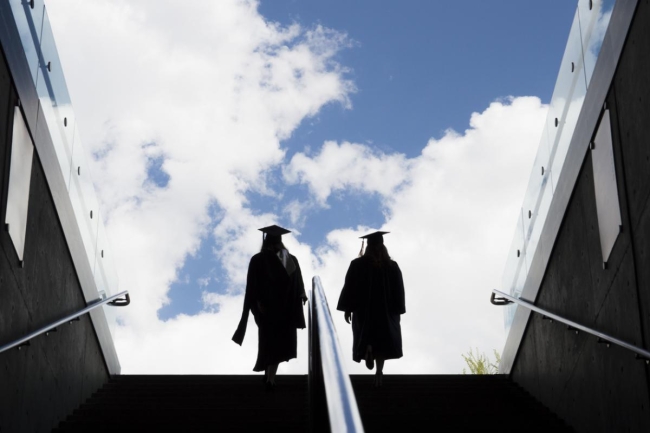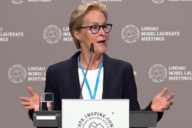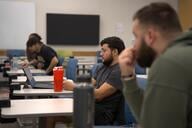You have /5 articles left.
Sign up for a free account or log in.

Istockphoto.com/Aaron Hawkins
The upward trajectory of college completion rates is slowing down, according to the latest national college completion report.
The National Student Clearinghouse Research Center found in its latest annual data report on college completion that, while completion rates have been on the rise for each cohort year beginning with the group who entered college in 2009, the growth is slowing.
While that's troubling, higher education advocates say the general message is positive.
"To me, the important part of this is the direction that we’re moving," said Terry Hartle, senior vice president of government and public affairs for the American Council on Education. It's possible institutions made significant progress in the first few years by choosing "the lowest-hanging fruits," he said, and further progress will be more difficult to achieve.
The report follows the pathways of first-time college students and stays with them even if they transfer. This year's report analyzes the outcomes for students who enrolled in 2013, as well as the eight-year results for those who enrolled in 2011. It is the most comprehensive assessment of completion data available for the sector.
Six-year completion rates are up across all sectors, but those who started in private, for-profit, four-year colleges had the biggest jump in completion, increasing from 37.3 percent to 42.4 percent.
"While we want to celebrate the increase in completion, it is lower than it has been in previous years," said Courtney Brown, vice president of strategic impact at the Lumina Foundation. "I think we have to figure out a way to be better."
The report also found that more students from the 2011 cohort completed college during their seventh and eighth years. The eight-year completion rate for that group was five percentage points higher than the six-year completion rate, which Brown said may be indicative of students who are attending part-time. Given that, she said, institutions need to address how long it takes to earn a credential if you must attend part-time.
Compared to previous cohorts, students who enrolled in 2013 were more likely to be of traditional college-going age, 20 or younger, while the proportion of adult learners over the age of 25 declined by almost one percentage point.
While their numbers may be declining, adult learners saw their completion rates increase by more than two percentage points. The rate for traditional-age students also increased, but by just 1.2 percentage points.
"Nontraditional students seem to be making especially rapid gains," Hartle said. "I think what we see there are efforts being made by institutions that serve nontraditional students."
Enrollment at four-year institutions increased slightly, the report found, while enrollment at two-year colleges decreased. This is likely at least partially due to the countercyclical effects of the economy on community college enrollments, according to Hartle; when unemployment is high, more people tend to enroll in two-year colleges to finish degrees or gain more skills to increase their employability, and vice versa.
While racial and ethnic completion rate gaps still persist, the report found some improvement, though advocates said it's not enough.
"There are still significant racial and ethnic disparities in terms of who completes college," said Wil Del Pilar, vice president of higher education at the Education Trust. "While there have been some gains in college completion among African American men, it’s not enough.
Despite the gains in completion over all, about 40 percent of students -- around one million -- are still leaving college without a credential.
"The bigger concern with that 40 percent is they’re more likely to be adults, more likely to be at two-year institutions, more likely to be students of color," Brown said. "These are the students we have to think about how we can better support."
It's especially concerning given the National Student Clearinghouse report released in October, which found that 36 million adults have some college credits but no degree, she said. "If we continue to lose a million more a year, that's a problem."
Another recession could further complicate matters with completion. The increase in completion rates was highest between 2009 and 2011, which the report states reflects a "post-recession effect" on the size and composition of the student population. Another economic downturn likely would increase enrollment, Brown said, but negatively impact completion, as students leave college to work when the economy improves.
"If and when we get another recession, the higher education system needs to be much better prepared to help these new enrollees get a credential of value faster," she said. "We have to think about how we can better support those students now."
While there are things institutions can do to help students succeed, they usually have a "marginal" effect, according to Hartle. From his perspective, college completion is a combination of three things: academic preparedness, commitment and financial resources.
To improve student success, work has to be done earlier in education to improve academic preparation. The latest national test results show modest gains, he said, and students who are underprepared often have to take remedial courses, which makes them less likely to complete a degree. If students do persist, they often later run into problems with financial resources, he added.
"There’s good news here, but in no way can people be satisfied that we solved the problem," he said, later adding, "It's a multifaceted problem. Those are the most difficult to solve."




